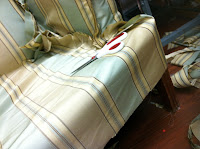Fold your triangle in half to make it easier to reach across.
Then cut away. I like to cut 2 1/2" wide strips. When the triangle gets too small I toss it. You don't want too many seams in your welting.
You end up with a pile like this.
Now sew them together to make one long strip like you would a mitered edge.
You will need a zipper or left welting foot and piping insert. I use a standard 15/32 cord welting.
Fold your strip in half with the piping inserted and sew away!!!
Now the fun begins! Get lots of pins out. I usually like the T pins. They stay in well. The last thing you want is to spend hours pinning and have it fall apart. This fabric had an extremely tight weave. My T pins had a hard time going through. I opted for the flower head long pins. These are extremely sharp! Trust me, my fingers know! I start at the back of the chair. Place your welting on the top and pin in place to hold. Make sure you have enough on both sides to reach the full length of the chair. The selvage edge should face away from you.
Line your fabric on the back of the chair, right side facing the chair. You will be pinning the whole cover inside out. Make sure to center your pattern. Place a few pins on top to hold in place. Make sure to keep the size of your welting in mind when leaving allowances for sewing.
I now pin a zipper along the whole length of one side with the welting in between the zipper and the back fabric.
now cut the front of the fabric lining up the pattern with the back of the chair. I place my fabric in front of the chair and tuck it in well on the sides. I then leave at least three inches extra on both sides.
Pin all three layers together. Front, back and welting in between. Make sure to match all patterns and place a lot of pins to prevent shifting.
I then move on to one outside wing. I place the fabric centered on the wing. I place a pin on top and the upper corners to hold in place. I now pin along the side of the back fabric. If you are having trouble molding your welting to the curves, cut snips to allow for movement.
The other outside wing gets pinned to the other half of the zipper. The back should look like this now. I took the picture on a strange angle. The fabric is centered.
Lets move on to the inside wings. Again line up your patterns. Tuck them in and allow 3-4" extra selvage. Place welting on the top back edge. I open about two inches of the welting and cut some out. This ensures you don't have too much bulk to deal with when sewing.
Pin inside wing to outside wing with welting in between. Start at the top back edge. Work your way to front top. Stop before corner. Pin front sides leaving only corner open. You should now have excess fabric at the corner. Make several small pleats to get rid of this excess. Repeat on the other side ensuring to match pleats and patterns.
The front should look like this. Take note of all the excess I have left.
Next, lets move on to outside sides. Line up your pattern to outside wing. Place welting in-between. Pin to back fabric and outside wing fabric.
Notice I have been cutting my lengths to bottom edge of chair plus seam allowance the size of my welting.
Now lets cut the inside arms of chair. Line up your patterns and cut enough to tuck and enough to reach over the arm and pin to outsides. You will see its awkward to get around the bottom of the wing. I cut plenty of slits here. Use lots of pins to ensure a good fit.
I now cut the arm fronts. Decide what you would like to center. Place welting in-between arm front and inside arm and outside fabric. Cut slits as you need.
Lets cut the seat now. Place your fabric on the seat. Leave enough length to tuck in with excess and to reach the front bottom edge of chair plus seam allowances. You need enough width to tuck in sides with excess and fold down front sides to bottom edge of chair with seam allowances. Pin to back and sides of fabric. Fold down front sides. Pin to outside fabric and bottom of arm fronts. You will have excess in front corners. Make a dart and trim. Also pin the edges of your excess along the insides the of the chair.

The chair now look like this and its time to sew!
Slip it off and sew all seams slowly. Take care to keep all patterns lined up and to sew very close on curves. Then do a fitting. If it is not perfect, open the seam and do it again. Now place the slipcover with the right side of fabric up. Pin welting along all bottom edge of chair.
Take cover off and sew in place under the zipper when you come to that corner. Place cover back on and pin a skirt on. I chose a very short skirt with corner pleats. You can go long or short, pleated or ruffled. The possibilities are endless. I then serge all seams and press. When you put the cover back on for the last time, make sure to tuck all he excess you left deep in the chair. This will ensure no movement when you sit on the chair. Make your cushion, again matching patterns to those on the chair.
I hope this helped. Send me pictures of your projects. Don't be discouraged at first. Do as many fittings as it takes and practice, practice, practice!!!!






